The trip was a program under Japan International Cooperation Center or JICE. It’s basically an organization under the Japanese government that contribute to the development of the global society through activities pertaining to strengthening mutually beneficial relationships between Japan and other nations. The program I fell under was the Jenesys program. If I didn’t spell it out, it kinda sounds like a super secret government program that was designed to send the first humans to a new world, in a sci-fi movie but it was kind of as tiring and amazing.
The programme assigned to us was designed with a focus on female entrepreneurship. We were given activities that would allow us to observe the city and participate in local activities. It was set to enable to not only learn the history, culture, and industry of the host country in a comprehensive manner, but also promote greater understanding about Japan’s role as a developed country by visiting sites where Japan’s ODA is provided.
Day 1: Naritasan Shinshoji Temple
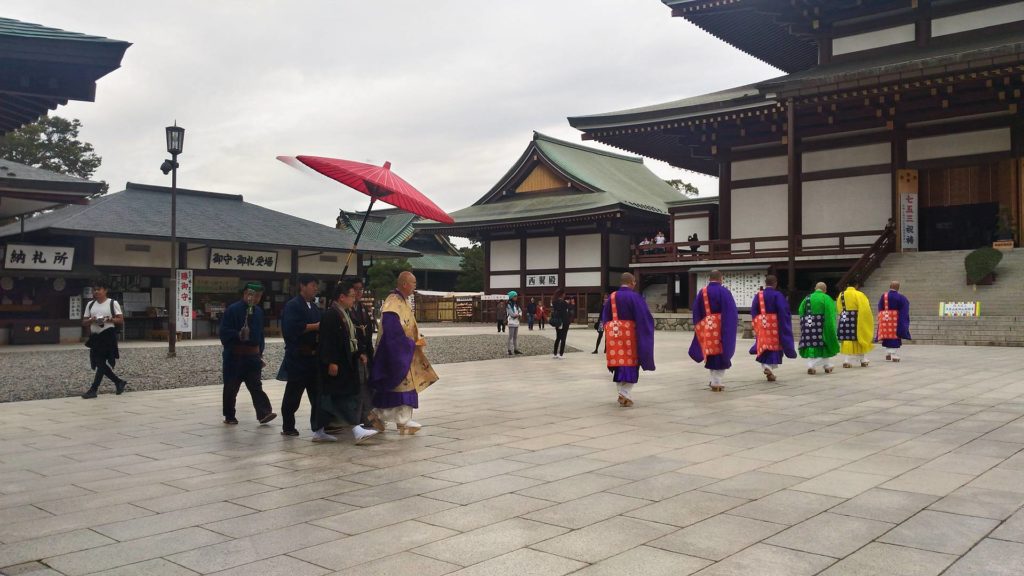
The March of the Monks Naritasan Shinshoji Temple
To be honest, it was probably the only time where we had a free and easy experience. Our Japanese coordinators allowed us to roam around the area and just gave us a call time for lunch. I was fortunate enough to be right in front of the temple during the march of the monks. It felt surreal. The surroundings were all pale and earthy, and then, came the monks, with their colored robes, enveloped by incense.
If you ever visit the temple, make sure to go around the area. There are so many hidden nooks and gardens to find. I remember being in front of a wall and asking a co-delegate where the sound of water was. There was a stream right on top of it.
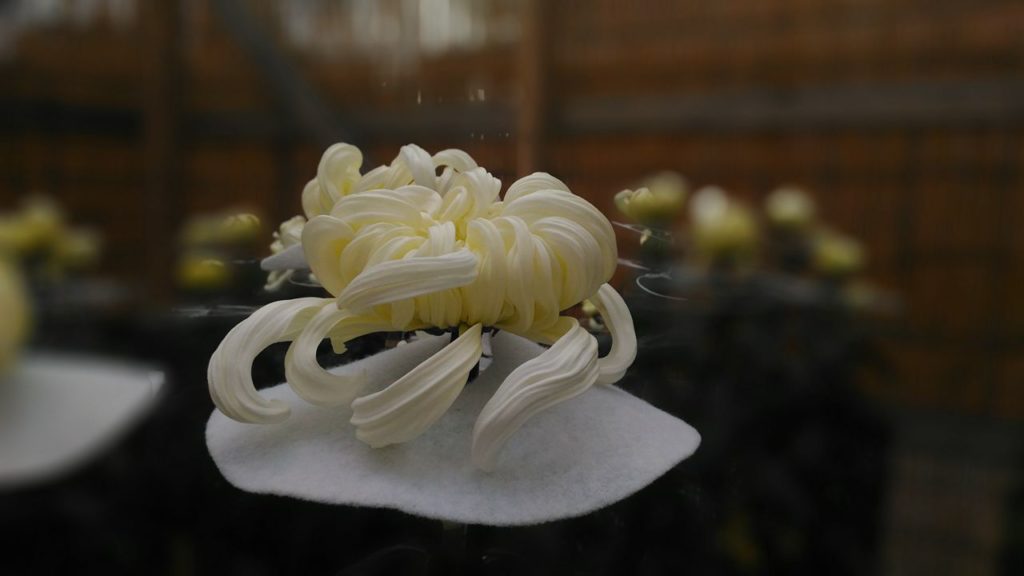 They also grow a lot of gorgeous plants. Check out this amazing flower that looked like a cake decoration.
They also grow a lot of gorgeous plants. Check out this amazing flower that looked like a cake decoration.
Also, while we’re at it, a new-found appreciation for my phone camera. The space isn’t enough so I’ll be posted a gallery of all the pictures me and my co-delegates were able to shoot during the trip.
You also shouldn’t miss getting your fortune from the stand in front of the temple. The best thing about it is, if you don’t like it, you can just tie the paper up on a stand and wish the bad luck away. Remember people your fortune is still in your hands.
Day 2: Shinkansen, Nanbu Town and Ikoi-No-Mura Restaurant
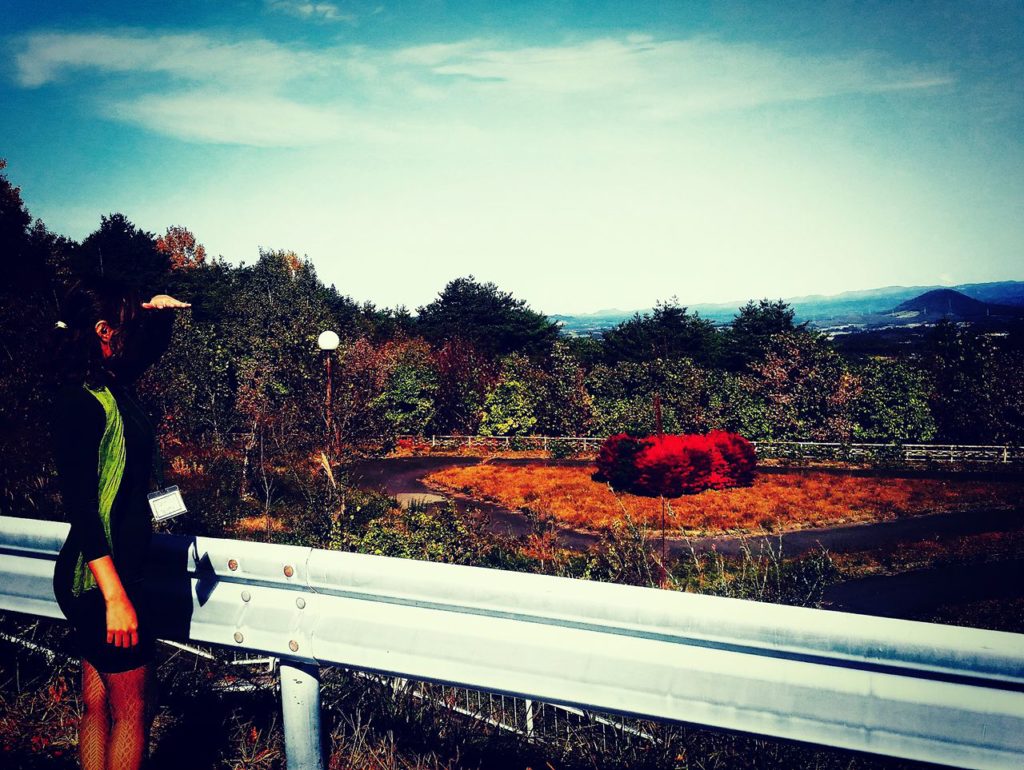
Where’s that filter?
So, one of the highlights of the trip was running in the streets of Tokyo to make it to our train ride to Tokyo Station. Imagine Filipinas with huge bags and small luggages running in a single line, behind a lady with a flag, like ants. But, if we wanted to make it to the train, that’s what it took. Also according to my friends, it would not have been a complete experience if we didn’t have to run because of a train schedule. So there. Tokyo experience kinda complete.
The ride to Morioka, was a bit of on and off, however, during the times that I was awake, it was evident that their country-side was filled with solar farms every now and then. It was a marvel to behold, both frustrating and hopeful, for my own country.
The lunch location, Ikoi-No-Mura resturant had an amazing view of fields and trees and mountains, I wish I knew what exactly I was looking at so I could share more. But there were some fun old Japanese playing croquet and asking us to join in.
The greeting party and courtesy call by the representatives from the Nanbu Town was also two-faced. On one side, it was admirable that they look at farming and farmers highly, on the other side, it was also the same as the Philippines, where only the old are left to tend the fields, and the young move to the city.
Day 3: JA-Hachinohe Agricultural Cooperatives, Hishizashi and meeting the Mayor
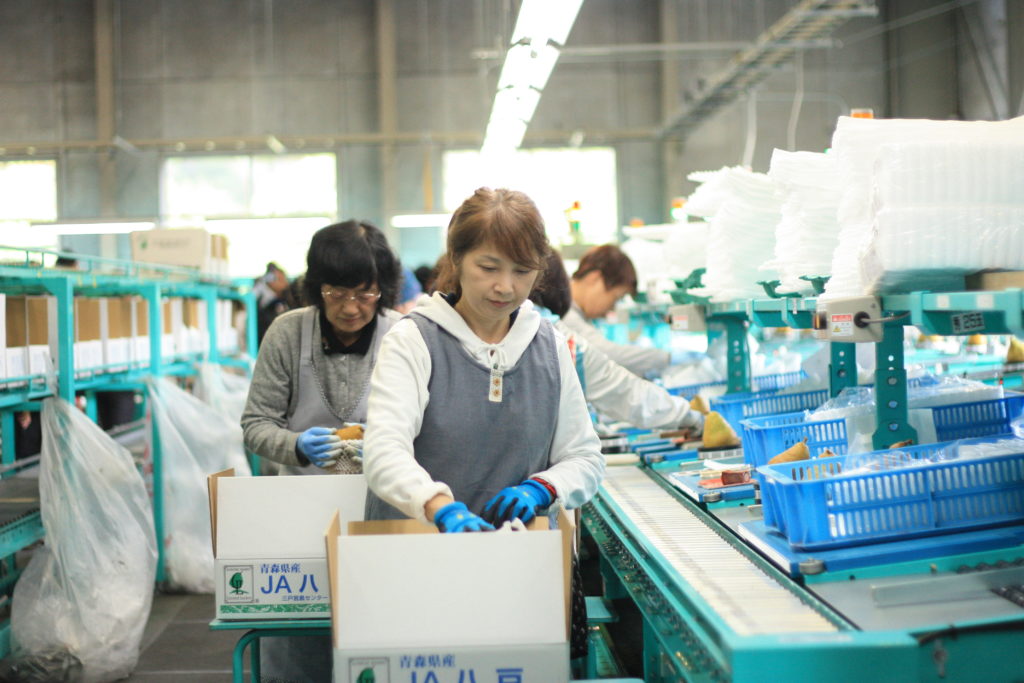
JA-Hachinohe packing establishment
The photo above is a cooperative-owned packing station. They only box pears here, which means they don’t use this the entire year, and yet, the location was state of the art. The pears are boxed manually, however, the fruits go through a machine that not only detects their weight, but also their sugar-content, grading it into different classes. The products are then exported to different cities in Japan, or goes to the wholesale market.
Their market is unique for us, in the sense that products go through bidding instead of a flat rate. You had to live in Aomari to be allowed to bid.
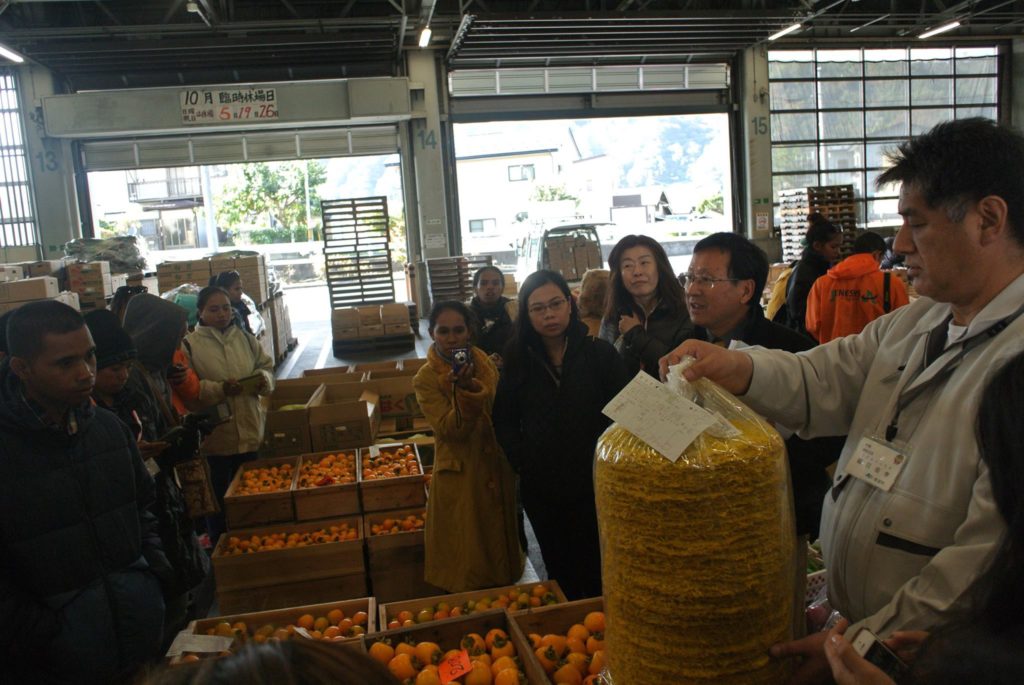
Hachinohe Cooperative Wholesale Market – The round yellow things you see are actually dried edible Chrysanthemums. They’re very expensive, and is one of their main local produce.
The market is also run by the cooperative. They take a percentage from the price and the rest goes to the farmer.
One thing that struck me on our visit to these establishments is the pride every member has in what they have created.
Being immersed in similar organizations in the Philippines, the delegates had several questions evolving around government assistance towards these projects. The spokesperson proudly said that almost all of the investment came from the farmers. There was a certain amount from the local government and only around 10% came from the National government. According to them, the National government already had so much responsibility outside of just helping cooperatives. And because of this investment, everybody was working towards its success.
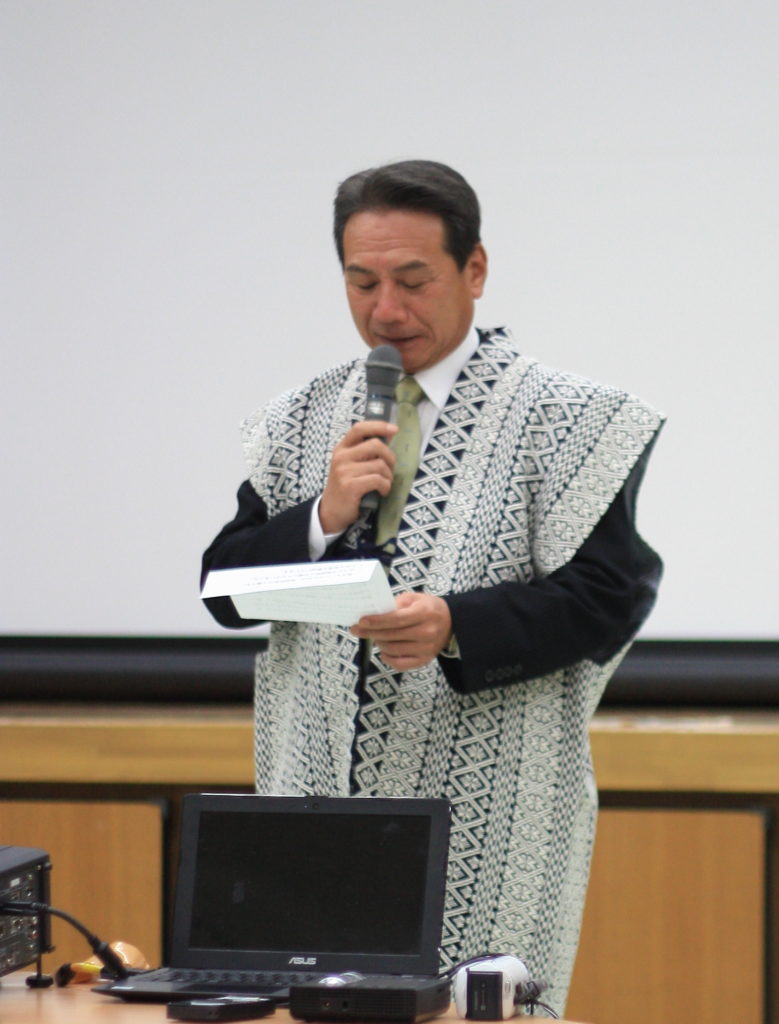
Hiroshi Shikanai, Aomori Mayor, wearing a piece that’s adorned with Hishizashe stitches sewn by his sister.
Of course, we understood the difference in circumstances as well, knowing that their farmers owned their land. However, it was enlightening and refreshing to hear a different point of view compared to our normal attitude that there should be government support above all.
The visit to Yutoria was an entirely different exposure. We were taught the local needle art called Hishizashi or the Nanbu diamond stitch. It’s history is very interesting. It was popular during the Edo period. The ladies would do this embroidery over clothes because apart from aesthetics, it helped retain heat reinforcing the clothes during hard winter when they were farming.
We were fortunate enough to try this art. We were instructed by lovely Japanese ladies on how to go about and follow our patterns. One of the instructors was the Mayor’s sister, which is one of the reasons we were fortunate enough to be visited by him during this trip.
It was loads of fun. Unfortunately, we only had a few minutes to try it and none of us were able to complete the pattern. I NEED to get back to it one of these days and establish a #TitasOfJapan embroidery group.
The sad part of this exposure was the information that many of their local arts are also dying, literally. The only artists remaining for many of the arts are very old and are slowly dying. They have been trying to continue the art by encouraging the young to take interest and revive their culture.
It seems like this is a common problem, which is something we also have in the Philippines. From the few that I saw, I truly hope that they succeed, and I wish the same for our own country.
On a lighter note, our lunch location was gorgeous once again. Below is the view from Cherius Restaurant.
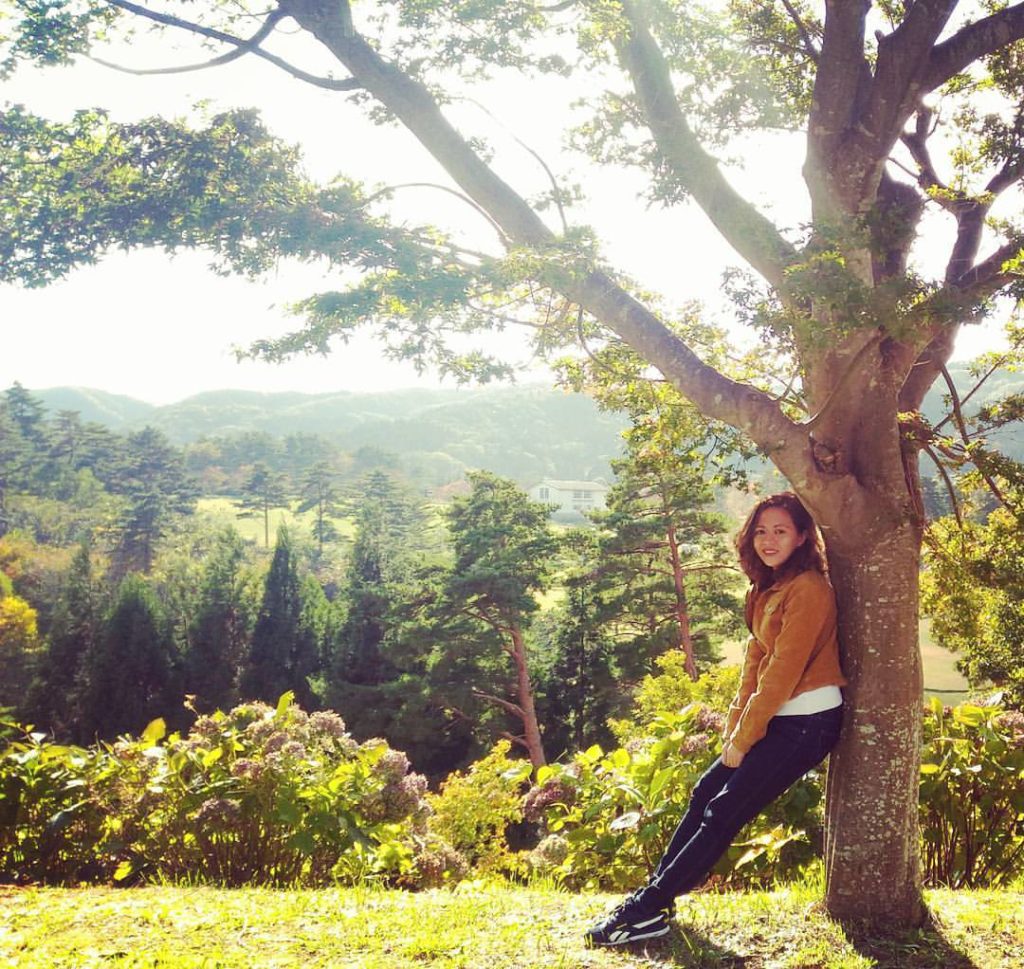
This is what happy cold looks like.
Day 4: Hachinohe Portal Museum HACCHI
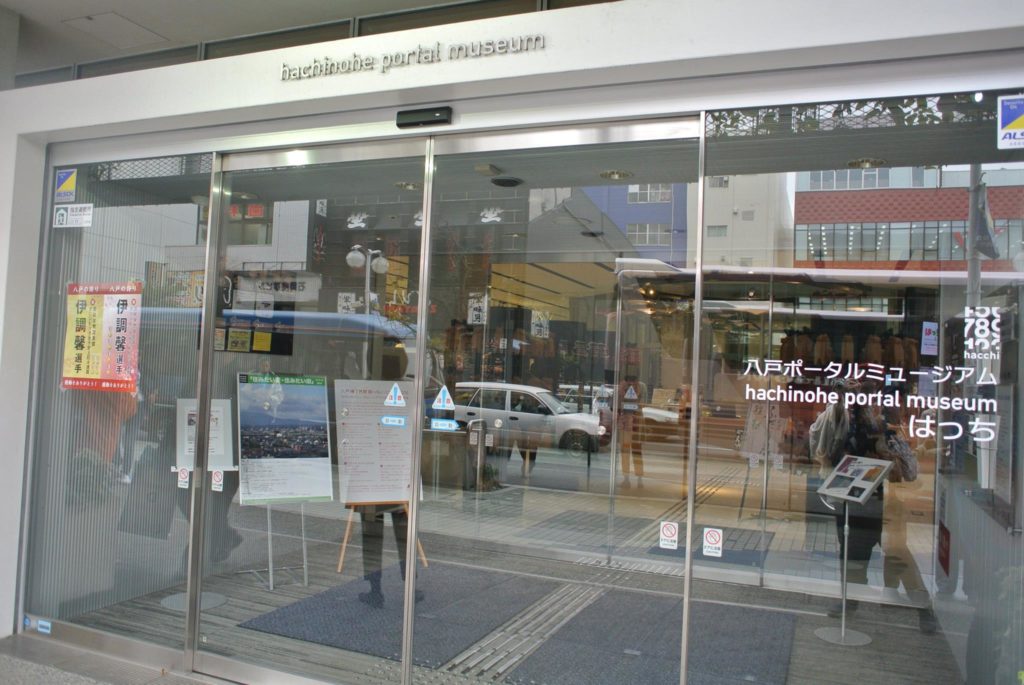
The HACCHI gallery experience was memorable. It’s the perfect marriage of the government, local entrepreneurs and the local arts community coming together to create an efficient system that was beneficial to all stakeholders.
The name of the gallery resembles the Japanese number 8, and so building itself was planned carefully. It was octagon-shaped, and the stairs had eight steps. Apart from showcasing local arts, the floors also have stalls where you can shop and dine. It’s an ingenious way of indirectly promoting arts and culture. The most impressive concept for me were the top floors. The 4th floor, features the artists’ work place, as well as a child space where artists can safely leave their children, allowing them to work. The 5th floor is the Open Studio, Artist Residence. This is usually a multi-purpose studio that is open to the public. There are also rooms that serve as residences for artists that want to create art projects for the downtown area.
Day 5: Homestay Yay!
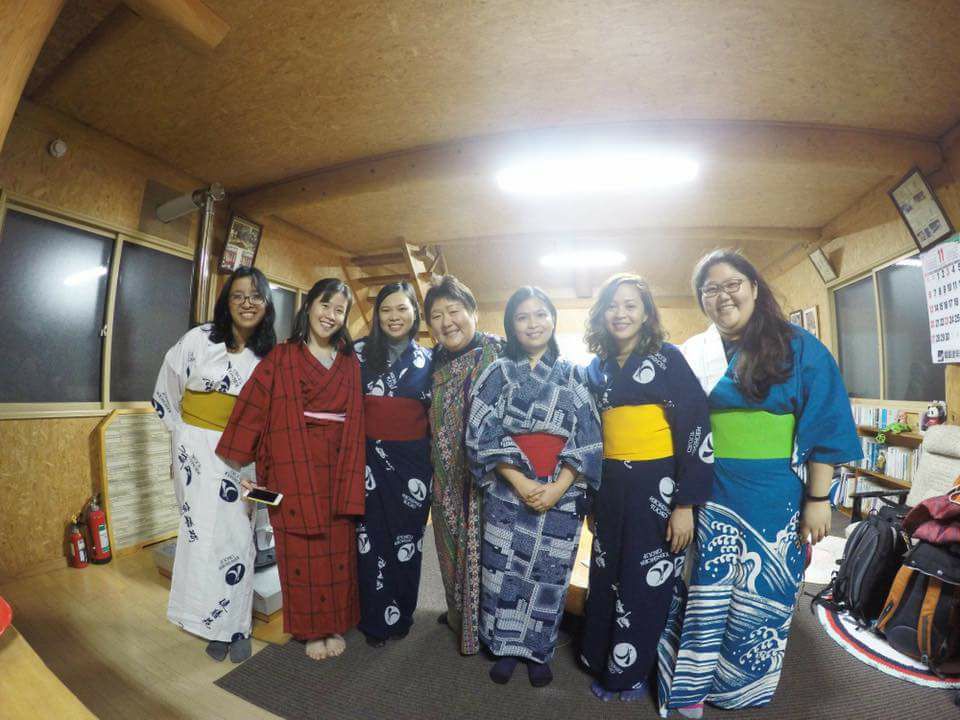
From left to right, Carissa, Jackie, Jenna, our mom Hisako-san, Ethel, me and Hannah in Yukatas and a Kimono. My homestay family!
This is probably the best part of the entire program. It was nerve-wracking because our family didn’t speak English, but I was lucky enough to be in a group where one of the members knew a bit of Japanese. Thanks Ethel!
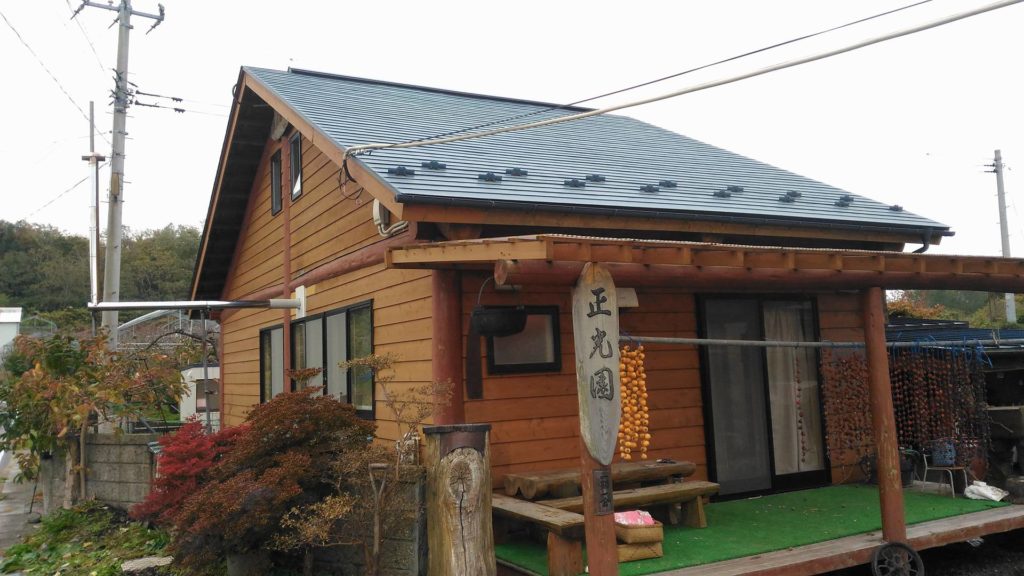 It was 1 day and 2 nights of warm Japanese hospitality. Our family had absolutely no qualms about anything and were extremely nice to us. The cat was a bit grumpy.
It was 1 day and 2 nights of warm Japanese hospitality. Our family had absolutely no qualms about anything and were extremely nice to us. The cat was a bit grumpy.
The family where we were assigned to was very traditional. In fact, on the group photo above, there was an old school heater where they put wood in and light to warm us up. We slept in the guest house which was a dainty 2 floor wooden cabin.
The orange and brown stuff you see hanging are persimmons. They start out as orange and turn brown when dried. They taste amazing.
The home-cooked meals were the best. Everything we ate was home-made or grown. They were very fond of pickled raddishes, it was the regular side-dish.
Our Japanese mom, Hisako-san took us apple picking and also drove us to a nearby waterfall. Their apples are huge and curiously juicy, I actually finished the entire fruit!
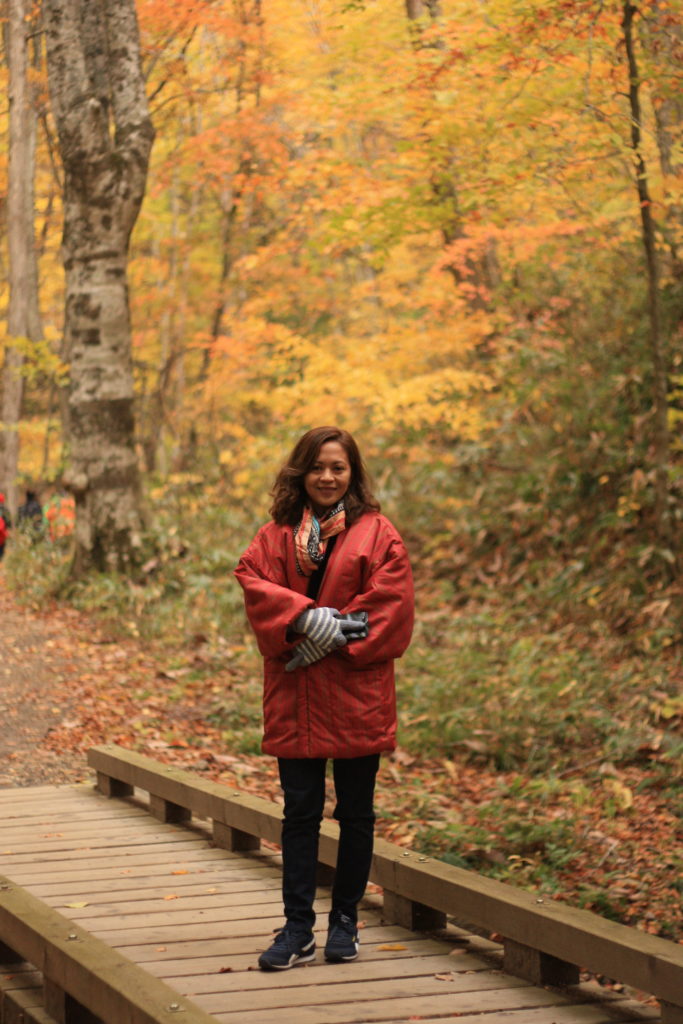
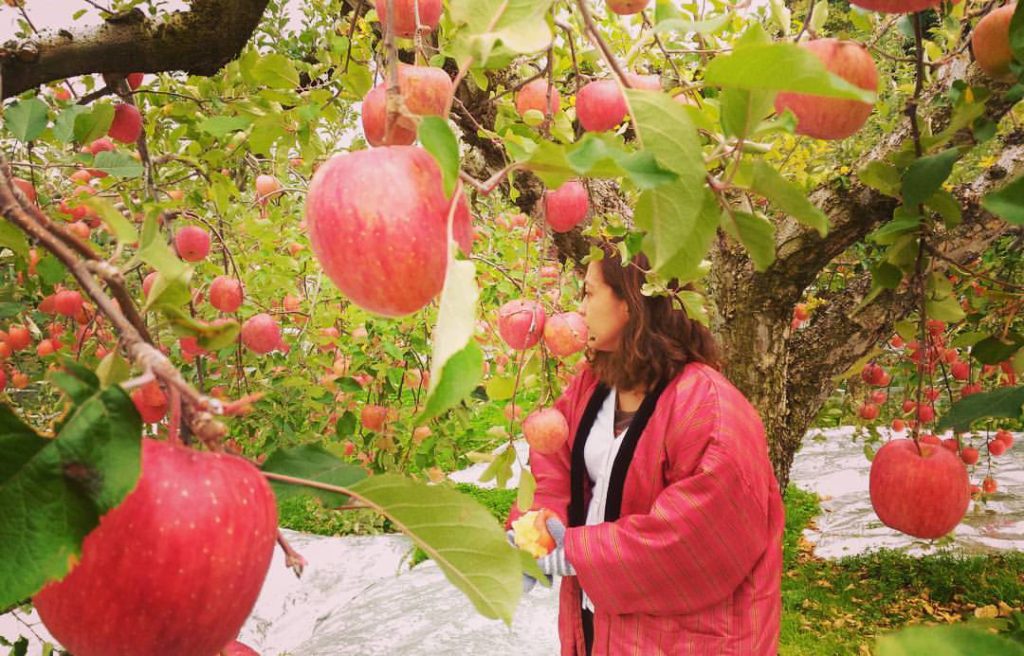
We were also fortunate because it seemed like Hisako-san was very active in her community. She was the head of the homestay family and had a lot of friends in town. She took us to the Cherry Market, a local store run by female entrepreneurs, and we were able to help out display some items. (Note: the raddish and other vegetables in Japan are huge!)
It was a wonderful experience, and I wish it was longer. We weren’t able to really get to know our family that well. Hopefully, we keep in touch.
Day 6: Hachinohe Gakuen University
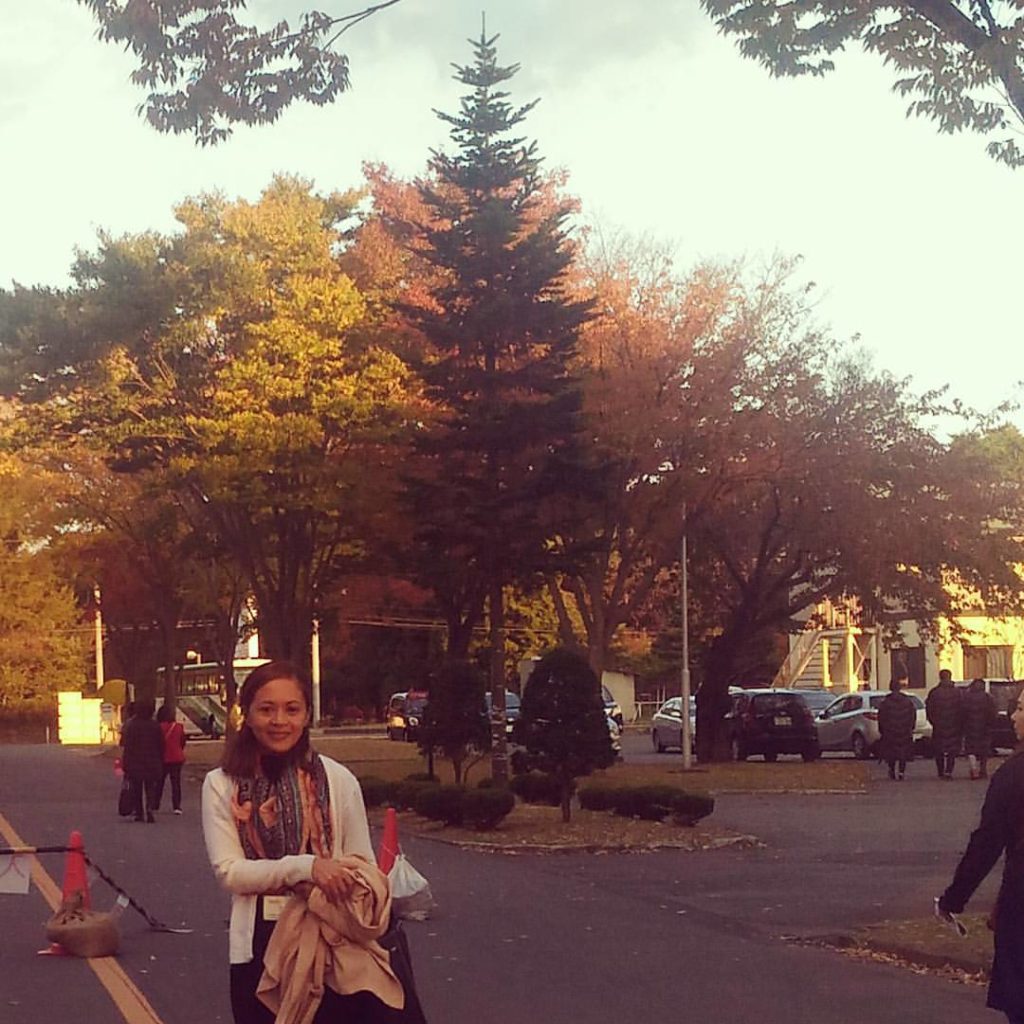 The visit to the University was perfectly timed because it was Halloween. They had a festival right outside their campus, unfortunately, we weren’t really able to go around that much. I missed the Takoyaki stall!
The visit to the University was perfectly timed because it was Halloween. They had a festival right outside their campus, unfortunately, we weren’t really able to go around that much. I missed the Takoyaki stall!
Fun experienced that I missed, going inside their “horror house” where a Japanese student wearing just briefs and a black trashbag would jump to scare you. Welcome to Japan!
The talks were very interesting though. The speaker was a developer who used to work for Nintendo and was part of the head development team for Wii. Backstory: The game was created because of a hot-pot dish.
According to the speaker, Japanese dinners, even among family are often quiet and formal. However, whenever this hot-pot was served, the meal seemed to be lighter and everyone would have a wonderful time. He wanted to create a game that would copy this experience instead of the usual games were the player would always be alone. He wanted to encourage interaction and fun among family members, and that was the concept behind Wii.
Day 7: Culmination Night
As part of the program, we were tasked to create a project proposal on how we would make this trip a fruitful one. Apart from the regular promotions that we planned on doing, our main project was to create an exchange program via the connections we made at Gakuan University.
It was a proud moment when, out of all the presentations, the Philippine delegate project was especially highlighted. Booyah!
For the entire night though, the one thing that I did remember the most was the Philippine dance presentation. Out of our 2 night practice, this was what we could scrounge up. Special thanks to Rose for the choreography. Dear Philippines, I hope we did it justice.
My Jenesys 2016 Entrepreneurship Batch 3 Learnings
Our itinerary was hectic, but well worth it. We only had 9 days, including arrival and departure, so I was glad to maximize my stay there. Never mind the 4-hour sleep nights or the constant search for coffee. It was a unique program that I would not have imagined creating if I ever visited Japan alone, and I was very thankful for every single activity, yes, even the dance presentation.
Japan’s rich culture and arts were of course notable. However, what has risen up out of the entire trip was the different Point Of View the Japanese always seem to have when it comes to duty and pride.
I admire the respect that they have for all forms of occupation. Their sense of patriotism for their country and their local towns is something that I envy.
As an entrepreneur, I hope that I am able to encourage the same pride the Japanese have among my staff when it comes to the value of their work, talent and skills.
As part of Dakila, an organization that promotes modern heroism, I hope that I am able to inspire the same sense of patriotism and love for our country.
During these trying times, both at work and the political troubles of our country, it’s always best to see a different perspective and to be forced outside of your box. In a life where I am used to leading, it’s a great experience to be an audience, to be there for the ride, and just absorb lessons I will value for a lifetime.
To learn more about JICE, Jenesys and their programs, please visit their website here. These programs are coordinated through the National Youth Commission. Thank you for the opportunity. I will continue to support and promote your programs and organizations.
Photos courtesy of Philippines c0-delegates.
My Philippine co-delegates are awesome. Here are some of their businesses/organizations:
Suelas
https://www.facebook.com/suelasonline/?fref=ts
Since we pioneered the foldable shoe line in the Philippines, we have made it our duty to give you style and comfort as you wander around the world. SUELAS is for dreamers and explorers, and for those who aspire to have the world at their feet.
Anthill
https://www.facebook.com/AnthillFabricGallery/?fref=ts
ANTHILL (Alternative Nest and Trading/Training Hub for Indigenous/Ingenious Little Livelihood seekers) is a cultural and social enterprise that supports and establishes community weaving enterprises by providing market access and transforming existing resources, homegrown skills and living traditions into innovative and contemporary lifestyle products. In this hub, fabrics are more than just ingredients to fashion; it is a way of life, it is where culture meets style.
ECPAT
https://www.facebook.com/ecpat
We coordinate research, advocacy and action to end the commercial sexual exploitation of children. We support the protection of children and empowerment of 90 members in 82 countries.
PinoyME Foundation
https://www.facebook.com/PinoyME.Foundation/
The PinoyME consortium serves as the instrument of the People Power of microenterprise by employing a four-pronged strategy of resource mobilization, capacity-building, knowledge management, and business development services in promoting entrepreneurship among poverty-stricken Filipinos.
CustomMade Crafts Center
https://www.facebook.com/custommadecrafts/?fref=ts
CustomMade Crafts Center, Inc. (CMCC) is a sustainable social enterprise that connects modern-day lifetyles with indigenous life ways. CMCC partners and sources out products from indigenous and rural communities and markets them to contemporary consumers through mainstream and alternative channels. In developing quality products, CMCC works with community artisans to develop their craft and build their capacities, making sure that in the process their age-old customs and traditions are kept alive.
Messy Bessy
https://www.facebook.com/messybessycleaners/?fref=ts
Messy Bessy is a line of natural, safe and locally-made home and personal care products. We thought you’d like to know that Messy Bessy is the first social enterprise that supports H.OU.S.E. (Helping OUrselves through Sustainable Enterprises) Foundation, Inc. Through HOUSE, the company educates, trains, and develops formerly abused, trafficked, and/or incarcerated, out of school youth.
Balud Boooks
https://www.facebook.com/baludbooks/?fref=ts
Balud Books fulfills dreams and empowers Filipino families from poor communities in developing barrangays of Mindanao by guiding them into becoming professional artisans of our locally produced products. Our items all have distinctive designs and content like the use of Indigenous fabrics, stories written in the mother-tongue and hand-made crafts from uniquely Filipino materials.
Balay-Balay 3D Architecture Puzzles
https://www.facebook.com/Balaybalay3D/?fref=ts
The makers of 3D Architecture toy puzzles of Filipino Architectural Landmarks, Traditional Houses, and Vernacular Architecture made for adults and children

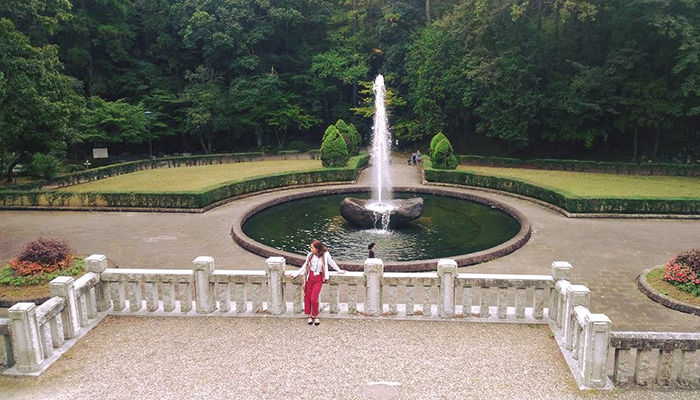

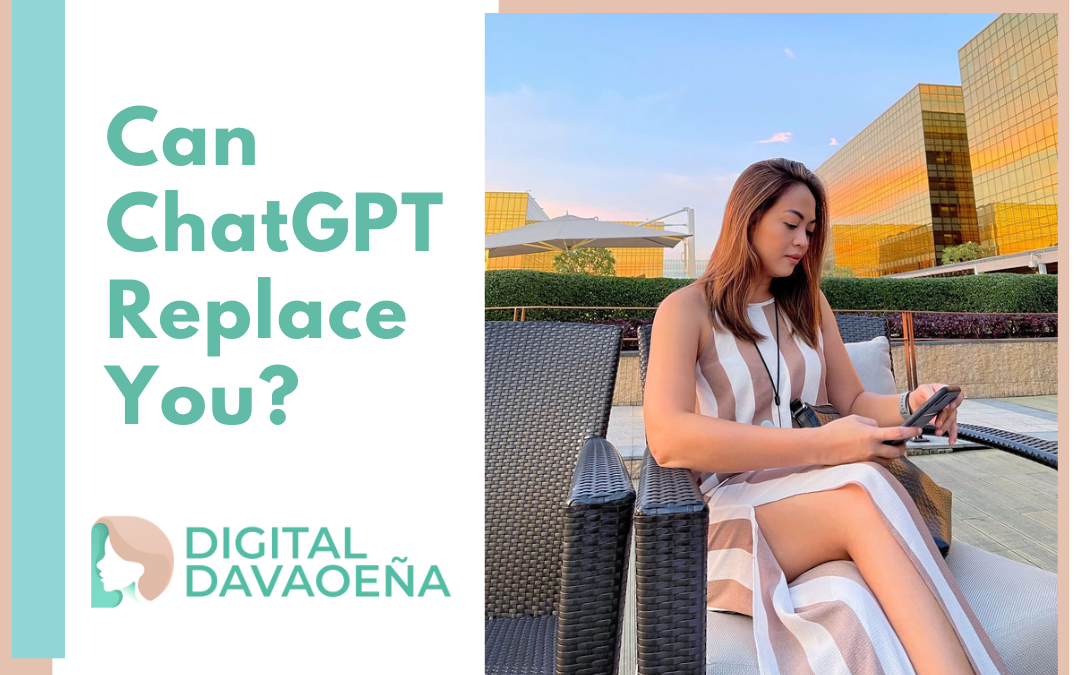



0 Comments